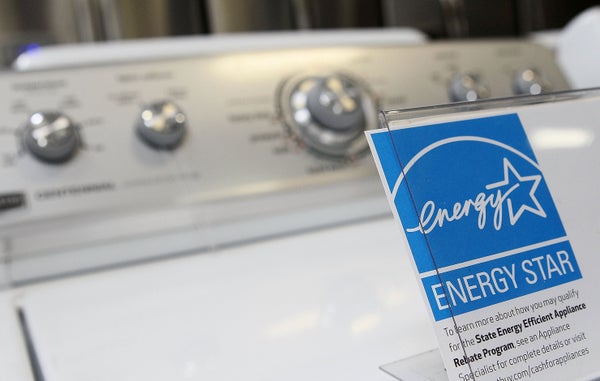WWW.SCIENTIFICAMERICAN.COM
The EPA Plans to Terminate the Energy Star Program. Here’s What That Means
May 8, 20253 min readShuttering of EPA’s Energy Star Program Would Affect Electric Bills and the EnvironmentHit by restructuring, the EPA is reportedly planning to end the Energy Star program, a project that has saved hundreds of billions of dollars for businesses and consumersBy Stephanie Pappas edited by Dean VisserAppliances with an Energy Star label have met certain energy-efficiency benchmarks. Justin Sullivan/Getty ImagesThe Environmental Protection Agency plans to do away with its Energy Star program, the New York Times has reported—signaling the end of an efficiency certification project that has helped families and businesses save more than $500 billion in energy costs since 1992, by the agency’s own metrics. The EPA has not yet made the cut official, but employees were told in an internal meeting that Energy Star would be eliminated, according to the New York Times.What Is Energy Star?First put into place 33 years ago under the administration of then president George H. W. Bush, Energy Star is a testing and certification program for appliances and electronics. Businesses can use the Energy Star logo if their products are third-party certified as meeting the EPA’s energy-efficiency specifications for the program. The agency oversees continued postmarket testing of appliances and electronics with the label to ensure they are still performing up to snuff.On supporting science journalismIf you're enjoying this article, consider supporting our award-winning journalism by subscribing. By purchasing a subscription you are helping to ensure the future of impactful stories about the discoveries and ideas shaping our world today.Additionally, consumers can get rebates and tax credits for purchases of Energy Star–labeled products. And the program also certifies energy-efficient homes and apartment buildings, commercial buildings and industrial plants. These certifications affect local building-code benchmarks and tax incentives for homeowners, says Steven Nadel, executive director of the American Council for an Energy-Efficient Economy, a nonprofit research organization focused on reducing energy waste.“The consumer labeling is the headline, if you will, but there are all sorts of other implications of this that aren’t as well understood,” Nadel says.What Are the Effects of the Energy Star Program?According to an annual Energy Star report released by the EPA in May 2024, the program has saved more than five trillion kilowatt-hours of electricity since 1992 and has prevented four billion metric tons of greenhouse gas emissions in the same period. More than $100 billion of Energy Star products are sold each year. And a 2022 survey found that 89 percent of Americans recognized the Energy Star label. Among the respondents who did so and had purchased at least one product with the label, 57 percent said the Energy Star designation was very or somewhat influential in their purchasing decisions.According to the EPA’s 2024 report, each dollar that the EPA spent on the Energy Star program spurred $230 in spending on energy-efficient infrastructure and services by homes and businesses. The EPA estimates the program saves a typical household $450 on energy bills each year.In April a group of more than 1,000 manufacturers, building owners and small businesses signed a letter asking EPA administrator Lee Zeldin to keep the program, which today has an annual cost of about $32 million.“Most economists would agree it’s generally a pretty good use of federal funds,” says Joe Craig, chair of the department of economics at the University of Colorado Colorado Springs. Companies voluntarily participate in the program, and consumers voluntarily decide whether to buy products with the label. “You could argue, in theory, it should be done by the private market, and the government shouldn’t be involved at all,” Craig says. But he notes that few private companies are funded well enough to run such programs.What Will Happen without Energy Star?There are a few other energy certifications that consumers and industry can turn to in the absence of Energy Star: LEED (Leadership in Energy and Environmental Design) certification for buildings, for example, or specifications for products from the nonprofit Consortium for Energy Efficiency (CEE). Unlike the EPA, however, CEE does not independently test or certify products, and LEED certification is limited to architecture.States and the federal government set energy-efficiency standards. These are minimum requirements, however—not the higher bar of efficiency set by Energy Star.“If it disappears, will there be something?” Nadel says. “Probably, but my guess is: it will probably be very ad hoc.” Utilities and states might set their own energy-efficiency benchmarks, yet that situation will be challenging for manufacturers to navigate, he says.“People like that uniformity around the country,” Nadel explains. Outreach to consumers is also more difficult for a patchwork of local and state-level programs compared with one well-established, widely recognizable federal program, he adds.“They haven’t worked out most of the details,” Nadel says, “so time will tell how this evolves.”
